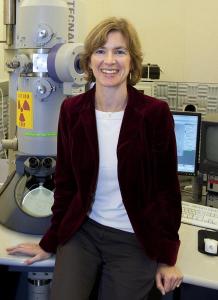WASHINGTON — Amid the ongoing debate about the ethics of a potent genome editing technology called CRISPR, Jennifer Doudna, one of the technology’s pioneers, has called on scientists to adopt a more open dialogue with the public about its implications and future use.
“Having transparent conversations is about including the public, not blindsiding them with the technology,” Doudna said Feb. 13, following a plenary talk she gave at the American Association for the Advancement of Science (AAAS) annual meeting.
As Doudna explained, CRISPR allows the “DNA of cells to be edited much like word processing tools allow us to edit a document.” A technology that borrows machinery from bacteria, CRISPR has gained enormous traction in the past few years because it’s relatively easy to use. While it has positive implications for medicine and agriculture, some of its applications, such as potential use in humans, have raised complicated moral and ethical questions.
One of those questions is whether the technology should be used to target heritable diseases. By doing so, scientists could create genetic modifications that would be passed on to future generations, potentially manipulating the gene pool of an entire population. This past December, scientists and policy makers convened at a 3-day summit in Washington to discuss the issue and call for a moratorium on the application of CRISPR in the context of the human genome.
However, Doudna emphasized that it’s just as important to discuss these topics with the public. The advent of CRISPR has sparked significant concerns about designer babies and a dystopian future. These concerns may overshadow the technology’s positive implications.
“One of my fears is waking up one morning and reading about the first CRISPR baby and having that create a public backlash where people demand regulations that shut this down,” Doudna said.
Another issue that has been raised about CRISPR is exactly what makes it such a popular technology: its simplicity. Anyone with a basic knowledge of biology can use it, leading to concerns about misuse and biosecurity. In fact, James Clapper, U.S. director of national intelligence, recently included gene editing on a list of potential weapons of mass destruction. Although it’s not clear exactly how gene editing fits into this list, people have speculated CRISPR could be used to create viruses with the ability to lethally alter human genes. But Doudna emphasized that lack of responsibility, not the technology itself, could be the problem.
“In terms of biosecurity risks, I don’t think it’s any riskier than lots of other things that are out there,” she said. “It just sort of underscores that it’s really powerful technology and we need to be thinking responsibly about how to use it.”
What’s clear is that CRISPR technology is here to stay. Designer babies and treatments for genetic diseases are no longer ideas from science fiction. For these revolutionary applications, it’s a matter of when and how, not if, we incorporate them into the biologist’s toolkit.
“The science is moving very, very fast so I think scientifically we’ll get there,” Doudna said. “The question is just, is the public ready for that?”
Meagan Goldman is a senior at Williams College, studying biology. She is the founder and editor-in-chief of The ScientEphic: Williams College Science Blog.

